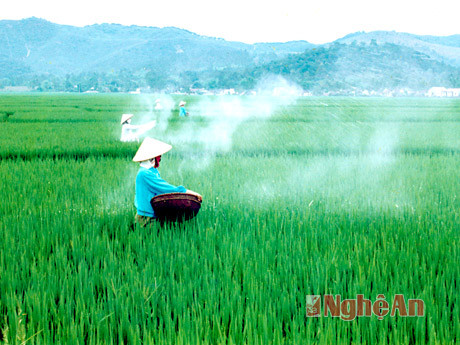For spring rice crop to achieve quality and efficiency
(Baonghean) - From a province with a serious food shortage, it has now become a province that not only has enough food to eat but also has a large surplus. In the current market, high quality rice is sold at a price 1.3 - 1.5 times higher than normal and low quality rice varieties. From this reality, the current rice production problem must aim at quality and efficiency to bring high income value to producers.
To achieve that goal, in this spring crop, production organization needs to focus on two major contents, which are the seed structure and the right, sufficient, and reasonable intensive investment. In this article, we would like to introduce how to invest in intensive farming to achieve high productivity.
The spring rice crop in Nghe An is an intensive crop, less affected by drought and storms. However, according to the forecast of the Central Hydrometeorological Department, the temperature of this year's spring crop will be higher than the average of many years and will be a warm spring crop. From that forecast, farmers should not sow rice earlier than the prescribed season, even a few days. The rice crop will have reduced productivity if the rice is allowed to bloom early in cold weather, with the air temperature when the rice blooms below 230C. Therefore, based on the growing period (TGST) of each different short- and long-term rice variety, ensuring the sowing and planting schedule according to the instructions so that all rice varieties bloom from April 25 to May 5 is the safest and best. Also, regarding the weather, this rice crop is very susceptible to severe cold, causing the seedlings to die after sowing. Therefore, spring rice should not be sown in the rice crop which is susceptible to frostbite and should only be sown for transplanting and sown with the use of plastic cover to prevent and protect the seedlings from the cold when the air temperature drops.
 |
| Farmers in hamlet 2, Bac Thanh commune apply lime to prevent pests and diseases in the 2012-2013 winter-spring rice crop. |
From the experience of the two spring rice crops in 2011 and 2012, we can sow and transplant according to the following schedule:
- Purebred rice variety AC5, hybrid rice variety B-TE1 sow from January 10 - 15, transplant when seedlings have 3 - 3.5 leaves.
Hybrid rice varieties Nghi Huong 2308, Nghi Huong 2309, Huong Uu 98, Bio 404, Khai Phong No. 1, ZZDOO1, N.Uu 69 and pure rice variety BC15 are sown from January 15 to 20 and transplanted when the seedlings have 2.5 to 3 leaves.
- Pure rice varieties Huong Thom No. 1, Bac Thom No. 7, VT- NA2, RVT, Nang Xuan, Nang Huong, Tam Xoan, TBRY and hybrid rice variety Syn6... sow seedlings from January 20 - 25, transplant when seedlings have 2.5 - 3 leaves.
Good varieties, high yield varieties, good quality varieties are the conditions for intensive farming to achieve high yield targets. But to achieve that target, investing in a lot of fertilizer, enough, balanced and applying it properly and at the right time is the solution to achieve high yield and large output. All rice varieties planted today have equal needs for nitrogen, phosphorus, and potassium, so no type of fertilizer can be overlooked in current rice intensive farming. The best solution is to use two types of NPK compound fertilizers, one type used for basal fertilizer before planting such as NPK 16-16-8 or 8-10-3, the other type used for top dressing such as NPK 15-5-20. The total amount of nitrogen, phosphorus, and potassium in both types of fertilizers above is itself balanced in the ratio of NPK 1.0.9.0.9, which is very suitable for all types of rice varieties today.
Doan Tri Tue






